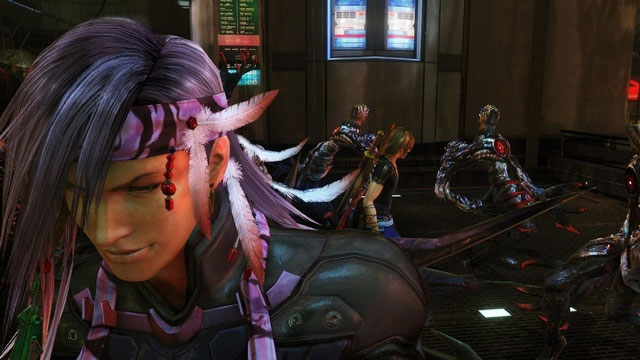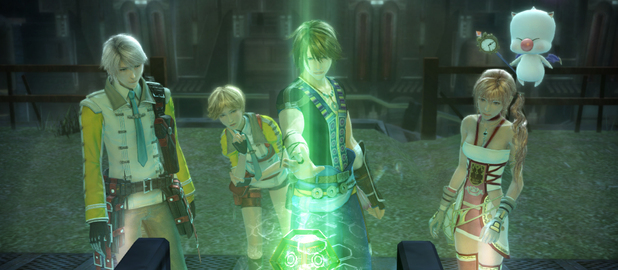Final Fantasy XIII-2
PS3
(reviewed), Xbox 360
Publisher:
Square Enix
Developer:
Square Enix
Release
Date: 31 January 2012
JRPGs
have suffered this console generation. The heavy hitters in the
genre have moved to hand-helds (like Dragon Quest IX)
or were met with fan backlash and derision (like Final
Fantasy XIII). The problems
facing XIII-2 were
daunting: the original was blasted for being too linear, not having
shops, taking way to long to open up into the larger world, having a
weak story/characters (I disagree on this point) and having a battle
system that was innovative, but also frustrating. The producer of
the game, Yoshinori Kitase, promised to rectify the issues fans
raised about the first game and deliver a sequel that not only made
apologies for the first game, but expanded and improved on the game.
I was worried, but after playing through, I can safely say, “Apology
accepted, Square Enix.”
Serah, Mog and Noel traipse through time
XIII-2
opens with the end of XIII.
The heroes have won the day and happy reunions are happening. But
Lightning is missing, even though Serah (her sister) remembers her
being there. Three years later, Serah is plagued by nightmares about
Lightning and the feeling that something isn't right. She then meets
Noel, a young man claiming to come from the end of days and a moogle
named Mog, a gift/lucky charm from Lightning. The three set off
through time to right the past and prevent the horrific future of
Noel's life. The trio right temporal wrongs, help others resolve
their various issues and strive to set history to rights again.
Honestly,
the story is one of the weaker parts of the game. Time travel is
always tricky to do properly, and the catch-all explanation of “time
paradox” wears thin rather quickly. The story also hinges on the
oft repeated axiom, “If you change the future, you change the
past.” I tried to wrap my head around that, even with the in-game
explanations, and still came away with a headache. While the
essential lynchpin of the story is bizarre, I found myself truly
caring by the end. I got wrapped up in the adventures and the
daunting choices made in the name of saving history. While the
ending offers up a “To Be Continued...” line, the story succeeds
despite a dubious premise.
Those crazy kids in love are reunited
One of
XIII's strengths, in
my opinion, was in characters that developed and were interesting.
Not many share that view, but I loved the cast of the original game
overall, even if they were whiny brats. I was honestly
worried about Noel, but he fast became one of my favorite characters.
He started off pretty standard as a JRPG hero, but by the end, he
had depth, tragedy and nobility. Serah similarly underwent changes,
but I wasn't as pleased with these. There were some essential
changes in her character that fly in the face of the entirety of
XIII's story. And
Mog, while cute, annoyingly adds “kupo” as a vocal tic. This is
adorable for about 3 seconds before it becomes the new “Hey! Listen!”. The returning cast are the same overall, though the new character
models are awesome (especially Snow). For XIII-2,
the supporting cast outshines 2/3's of the main cast, but that's OK.
Hope is back, and he's pretty cool
Graphically,
the game isn't as beautiful as its predecessor. The loads are the
biggest issue. Randomly long loads when opening the Historia Crux
(the map of areas you can visit) and the jarring loads before cinemas
were disappointing. It's still a beautiful game, but it suffers from
the shortened development cycle. The hair, in particular, suffers.
This is quibbling, but it was slightly disappointing after the
eye-melting beauty of the first game.
The
last negative thing has got to be the music. Final Fantasy
has always had a solid musical score. Over the years, games have
changed, but the music was always something you could count on to be
stellar. XIII added
vocals to some of the maps, which was strange, but oddly fitting.
XIII-2 continues this
trend, but makes some really awkward choices in lyrics. The “Crazy
Chocobo” sounds like something from the depths of Nu-metal Hell (of
note, the lyrics: “Saddle up and ride in this rodeo. Are we in
Hell, I dunno!”). This theme plays when you ride the Red Chocobo
(and strangely during a chocobo-free boss fight). It is an aural atrocity, in my opinion.
The rest of the soundtrack is a mix of acid-jazz, easy listening,
pseudo-rock and then a few amazingly beautiful orchestral tracks. If
it wasn't for the moogle alert sounds, which signify hidden items, I
may have played on mute. Music is a disappointment, but it's not
something that ruins the game overall.
Yeah, ride that chocobo! Nu-metal rocks!
Now
that the bad/dubious things are out of the way, it's time to focus on
the changes made for the better. The game's systems for combat and
leveling are different or changed for the better. This is where the
game is like a dance. There is positive movement overall, but
sometimes it seems like the steps are more sideways than forward.
The
battle system remains more or less the same, with some nice
streamlining and upgrades. Paradigm Shifts are now instant, and
don't interrupt attack streams. The same strategies that worked
before are still the same. The biggest and best change is that the
leader can die and it doesn't result in Game Over. As long as either
Serah or Noel is alive, the death of the leader results in a Leader
Swap and a chance to throw a recovery item. It's a small change, but
it takes the major complaint I had with the battle system in XIII
and fixes it perfectly. Although the battles are still too fast and
basically force you to use the Auto Battle system, it's a solid
battle system.
Battles are flashy and hectic as ever
The
biggest change is the addition of monster collecting. Monsters may
drop a crystal when defeated that will allow you to use that monster
in combat. Monsters fill a specific role in combat, such as a
Chocobo is a Commando, a Cait Sith is a Medic and a Pulsework Solider
is a Sentential. You can have three separate monsters in your party
who will swap out with each Paradigm Shift. After a time, the
monsters can do a Feral Link (think Overdrive, Limit Break, special
attack). These are monster specific, though some are more useful
than others. The “Bellow” of behemoths heals and instills
positive buffs on the party, while a gremlin will stop casting magic
and do a butt stomp. Each monster has it's own stats and
“personality” that determines development cost and level cap.
You can also combine monsters to add up to 10 passive skills. This
part of the game, so very much like Pokemon,
is addicting and making the perfect team is a fun diversion.
The
Crystarium returns in an altered form for XIII-2.
Each character has their own path to follow, with nodes large and
small that confer an extra bonus. The individual jobs now all share
the same path, and each job gives a specific bonus at each node.
Things like health come from the Medic or Sentential jobs, while
strength bonuses are generally reserved for Commandos and Synergists.
Instead of having multiple crystals per level, each crystal is now
a level itself. So upgrading three nodes as a Commando will up your
Commando level by three. When you complete a “lap” around the
path, all the nodes reset and you get to pick a “bonus.” Bonuses
are either new jobs, upgrades to a job (larger bonuses at nodes),
special attacks or larger accessory points (I'll get to those in a
bit). Monsters use materials dropped to upgrade. The higher the
level for the monster, the higher grade the material is needed. The
Crystarium was more muddled this time around, but it was still a
solid system overall.
Antagonist Caius Ballad: bad name, awesome character
The
other additions to the game are, again, steps forward and a bit
sideways. One of the biggest complaints about XIII
was how linear it was, and XIII-2
took that lesson to heart. Before too long, the game opens up and
allows you to pursue your own goals nearly unhindered. Hub areas
have plenty of people, some of whom offer side quests (something
completely missing before). In each area, a crazy half-chocobo lady
named Chocolina offers her wares. She shows up frequently, and
offers a one-stop shop for all your needs. A major improvement is
that weapons can be purchased. Nicer/Rare weapons can be crafted by
Chocolina if you have the right parts and base weapon/accessory.
This is a major improvement from XIII.
Accessories are handled differently this time around. Each
accessory has a value, and the more useful the accessory, the more it
costs to wear. You begin with 50 points, and most accessories cost
30 to wear. You can wear up to four accessories if you have the
points for it. I found the bonuses to each class more useful than
more accessory space, but that might just be me.
Repairing the timeline, one paradox at a time
Overall,
XIII-2 has everything
you could want from a JRPG. There are a lot of positives about this
release that have gone a long way to rekindling the magic of the
Final Fantasy series
to me. I loved the battle system, collecting stronger monsters and
wandering the timeline in search of lost items. The critical path
will take about 30 hours, and doing just that netted me only 58 of
the possible 160 fragments. The robust post-game content will offer
many more hours of entertainment for those willing to explore. There
is a deep chocobo breeding/racing game, casino games, a battle
coliseum and plenty of smaller quests to dive into. Square Enix
listened to fan complaints to make XIII-2
a better game. Despite some strange story elements and awful music,
the game is great. It's the first JRPG that I've lost track of time
playing in years. That is some of the highest praise I can give it.
Score:
7 out of 10
Bottom
Line:
Strange story aside, this game goes a long way to right the Final
Fantasy
franchise
Check
it out if you like:
Final Fantasy
series, PS2-era JRPGs






No comments:
Post a Comment